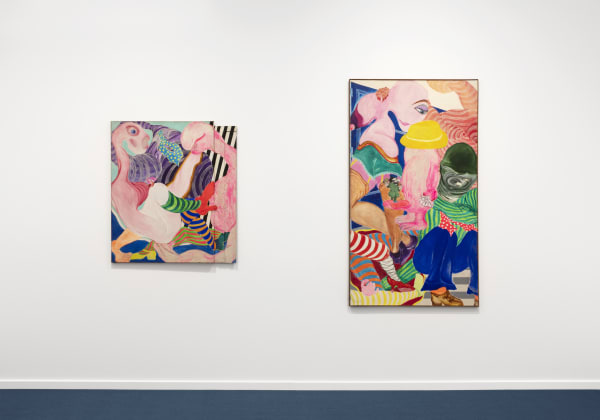For Frieze Masters 2019, Pippy Houldsworth Gallery is delighted to present, Please not!, a solo presentation of early paintings by Jacqueline de Jong. A key figure of the 1960s European avant-garde, de Jong was a member of the Situationist International and later publisher and editor of The Situationist Times. This will be the first solo presentation of her work in the UK ahead of an exhibition at Pippy Houldsworth Gallery, London, opening November this year. The booth will comprise works made at a time of instability, change and revolution. Three paintings made in Paris in 1968, the same year that de Jong participated in the May protests, will be included alongside four paintings from the Chronique d’Amsterdam series. Each of the works has been highlighted in her retrospective at the Stedelijk Museum, Amsterdam (2019).
In the late 1960s de Jong increasingly incorporated themes and motifs from advertising, film and television into her practice, reflecting a wider change in society. Living in Paris in 1968, de Jong produced posters for the May ’68 protests. During this year of great upheaval she made paintings that drew loosely on the erotic postcards which her partner at the time, Asger Jorn, had bought her. Characterised by their neon palette, these depict lovers in violent embrace, fluorescent pink bodies that curve around the space of the canvas, twisted and compressed. In La Cumparista a foot appears above a shoulder and the flat, fleshy expanse of a naked body entangles with a striped, suited tango dancer. The fluorescent pink skin appears again in Le dinosaur amoureux but the distinction between bodies is less clear. There may be two, three, maybe even four subjects compressed into this mass of limbs, lips, tongues and nipples. This scene, uncontained, spills into an additional fragment tacked onto the side of the canvas, demonstrating the sculptural dimension her work gradually acquired during this period.
In 1970 de Jong began working on small-scale canvases that she soon adapted for travel between Paris and Amsterdam. Later referred to as the Chronique d’Amsterdam, the works consist of paintings that resemble suitcases, making the itinerant nature of her life a literal component of the work. Painted on two canvases, hinged together, the works can be opened, closed and carried by a small handle. This format makes the diptychs portable and practical, enabling the artist to transport them with ease during a time of flux. Inside the ‘suitcases’ de Jong combines text and image, creating an equivocation of her daily life with major events and social changes of the period: feminism, sexual liberation and civil rights movements illustrate mundane diary entries detailing parties attended, hangovers experienced. Recurring images of sport, sex, doctors, holidays, cosmonauts and pinball machines re-appear in various configurations. In on example, a baby stands to the side of the canvas and urinates over three men – one, a gendarme, looks back unimpressed, whilst a headless footballer is simultaneously offered a missing head. The text in these works transitions between handwritten notes, loosely scrawled across the canvas to German ‘fractur’ print at the top of the painting, suggesting a newspaper heading. The links between various elements of these paintings rely, like other works from her oeuvre, as much on the viewer’s interpretation as the artist’s juxtapositions.
Jacqueline de Jong (b. 1939 in Hengelo, Netherlands) lives and works in Amsterdam and the Bourbonnais, France. Throughout a career spanning six decades de Jong’s work has explored the violence, banality, eroticism and humour of human interaction. Since the 1960s, she has developed a diverse practice that encompasses painting at its core, alongside drawing, sculpture, jewellery, artist books and printmaking.
De Jong was one of the two female members of the Situationist International (SI), with close ties to its founding members, Guy Debord and Asger Jorn. She was also closely involved with German collective, Gruppe SPUR. When visual artists were expelled from SI, de Jong founded The Situationist Times, one of the most important and experimental journals of the post-war period. As editor and publisher, she produced six editions between 1962 and 1967. The publication offered opportunity for collaboration between writers, poets and visual artists including Noel Arnaud, Jacques Prévert, Anton Ehrenzweig, Franciszka and Stefan Themerson, Max Bucaille, Aldo van Eyck, Lech Tomaszewski and Asger Jorn.
Earlier this year, the French Ministry for Culture, together with the AWARE Prize for Women artists, presented de Jong with the Outstanding Merit Prize in recognition of her exceptional career and here recently highlighted work. Recent institutional solo exhibitions include Stedelijk Museum, Amsterdam (2019); Museum Jorn, Silkeborg (2019); Musée Les Abattoirs, Toulouse; Malmo Konsthall (2018) and Moderna Museet, Stockholm (2012). Her archive, the Jacqueline de Jong papers, was acquired by the Beinecke Library of Rare Books and Manuscripts, Yale University in 2011. A major new publication exploring The Situationist Times in depth, These are Situationist Times! (Torpedo Press, Oslo) was launched this year at Stedelijk Museum, Amsterdam and MoMA PS1, New York.
Collections include Centre Pompidou, Paris; Stedelijk Museum, Amsterdam; Moderna Museet, Stockholm; Rachofsky Collection, Dallas; Cobra Museum of Modern Art, Amstelveen; Musée les Abattoirs, Toulouse; Museum Arnhem, Arnhem; Museum Boijmans van Beuningen, Rotterdam; Museo Comunale d’Arte Moderna, Ascona; Frans Hals Museum, Haarlem; Museum Jorn, Silkeborg; Henie Onstad Kunstsenter, Oslo; Kunstmuseum Göteborg; Lenbachhaus, Munich; MONA, Tasmania and MOCA, Toronto.




